|

Teacher
Resources
Entire
Unit | Music | Art | Battles | The
Patriot | Declaring Independence |
Slavery | Additional Resources
Entire
Unit
The
National Archives has developed a set of analysis
worksheets for documents as well as visual
media such as cartoons,
maps, motion pictures, photographs and sound recordings. They
are reproduced here on Digital History.
One way to introduce this unit would be to use a variety
of media such as:
 click
to enlarge
click
to enlarge |
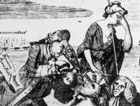
click to enlarge |
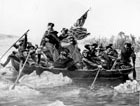
click to enlarge |
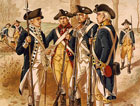 click
to enlarge
click
to enlarge |
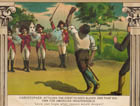
click
to enlarge |
The destruction of tea at
Boston Harbor. Lithograph by Sarony and Major, 1846.
National Archives.
|
The able doctor, or America
swallowing the bitter draught. Cartoon in line engraving
by Paul Revere for the Royal American Magazine,
June 1774. National Archives.
|
Crossing the Delaware. Painting
by Emanuel Leutze. National Archives.
|
Infantry: Continental Army,
1779-1783, c1897. Color lithograph by Henry Alexander Ogden.
Library of Congress.
|
Detail from Afro-American
Monument. Color lithograph. Goes Lithograph, Co., Chicago.
c1897. Library of Congress.
|
Lithograph
|
Political Cartoon
|
Painting
|
Color lithograph
|
Color lithograph
|
Possible questions include:
- What constitutes
a primary source?
- What can images tell us about the event?
- How are events depicted at a later time different from those
created at the time the event occurred?
For more information, use the Primary
Source Tools such as
Information
for students about Primary
and Secondary Sources from the National
Park Service
reproduced on Digital History.
Information about Using
Primary Sources in the Classroom from the
Library of Congress, reproduced on Digital History.
Back
to Top
Music
and the American Revolution
For
more information, use the Primary
Source Tools such as the worksheet developed by the Library
of Congress, Thinking
About Songs as Historical Artifacts and Thinking
About Poems as Historical Artifacts.
Using
Music in your Classroom:
These
suggestions are from the Library of Congress' resources for teachers.
- Preparation
- Choose a poem or song.
- Familiarize yourself with the historical
background of the piece.
- Duplicate copies of the graphic organizer
for each student.
- Download and duplicate one copy per student
of the printed primary source version of the chosen piece.
- Or,
arrange for the
class to view the document on screen.
- Decide how students
will hear the song or poem. Poems or song lyrics may be read
aloud, and recordings of songs
may be
played from the
Web or from the accompanying CD. A song can also
be sung or played from the sheet music.
- Initial Response
- Give students a few minutes to look at and read
the printed document silently.
- Read or play the piece aloud for
the whole class to hear.
- Have students respond to the piece.
Possible responses include paraphrasing the message,
free-writing a response, and drawing
a picture.
- Analytical Response
- Give each student
a copy of the graphic organizer for individual note taking.
- Have
students work in small groups to discuss and analyze the
piece as a historical
artifact,
writing
down their
individual responses
on the organizers.
- Discussion
- Have a spokesperson from each group
share the group’s findings
with the class.
- Hold a class discussion based on
some of the following questions:
- Who was the piece written for?
- What was the purpose of the
piece?
- What topic or concern
of the era does the piece
represent?
- What does
the piece reveal about the artist and
the artist’s
viewpoint? Do
you agree
with this
viewpoint?
- What does
the piece say about what life
was like
in the
past?
- What questions
does this piece raise?
How can
you find
answers?
Back
to Top
Art
as Propaganda
Political
cartoons are another way of extending art into history lessons.
Click on each image below to view in depth information about each
of these political cartoons about events in the American Revolution.
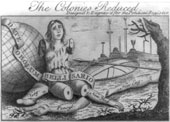 Click image to enlarge
Click image to enlarge |
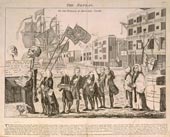
Click
image to enlarge |
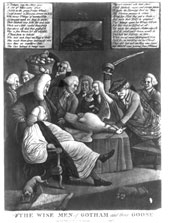
Click
image to enlarge |
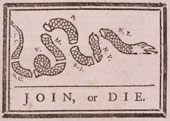 Click image to enlarge
Click image to enlarge |
The
Colonies Reduced
|
The
Repeal or the Funeral of Miss Americ-Stamp
|
Wise
Men of Gotham and Their Goose
|
Join
or Die.
|
Prints and Photographs Division,
Library of Congress. |
Prints and Photographs Division,
Library of Congress |
Prints and Photographs Division,
Library of Congress |
Prints and Photographs Division,
Library of Congress |
Consider
the following student inquiry questions:
- What
is the central image in the cartoon?
- Do
you think the image is effective in conveying the political
message? Why or why not?
- What
clues can you find in each cartoon that help viewers understand
its meaning?
- Do
you find some cartoons more effective than others? Why or why
not?
- How
effective do you think these cartoons were in influencing
political opinion of the time?
- Do
you think these cartoons
conveyed
the relationship
between Britain and her colonies more effectively
than could have been done with words?
- Are political
cartoons
are useful communication tools today?
Back
to Top
The
Battles of Lexington and Concord
The
National Park Service has several excellent resources on the
battles from Minute Man Historical Park.
Back
to Top
Mel
Gibson's "The Patriot" as History
The
Patriot Resource website has some good resources on distinguishing
fact and fiction in the movie, (CAUTION:This website does have
advertising.)
Main website: http://www.patriotresource.com/film/index.html
Fact or Fiction page: http://www.patriotresource.com/factfiction.html
There is information on the battles in the movie (Camden,
Charleston, Cowpens, Guilford Courthouse, and Yorktown), the people in the movie (Colonel Harry Burwell, General Charles Cornwallis,
General Nathanael Greene, Benjamin Martin, General Charles O'Hara,
Colonel William Tavington, and Major Jean Villeneuve). There is also
commentary about individual events depicted in the movie such as
"The "Betsy
Ross" flag used as a battle flag," "Escaped slave colonies
(Gullah camps) existed during the war," and "Colonel Tavington burns
down a church with the townspeople inside."
Back
to Top
Declaring
Independence
NOTE: These ideas are from the Library of Congress
lesson plan on the Declaration of Independence
http://myloc.gov/Education/Pages/lessonplans/education/lessonplans/declaration/index.aspx
Interactive Activity: Students can also take a close-up
look at Thomas Jefferson’s “original Rough draught” of the Declaration
of Independence,
and
then try their hand at crafting an alternate version of the nation’s
founding document. http://myloc.gov/Education/ExhibitObjects/CreatingTheUSOnlineActivity.aspx
1. Discuss students’ understanding
of a document. Ask the following questions to frame the
discussion:
- What
is a document? (e.g., a record of information)
- What are examples
of common documents? (e.g., letter, diploma, passport, driver’s
license)
2. Explain that in this lesson students will take a close
look at an important historical document. Distribute
copies and engage
students
with the first page of Thomas Jefferson’s original Rough
draught of the Declaration of Independence. (Note:
Do not identify the
document).
- Ask students to examine the document. Possible
questions include:
- Where does your eye go first?
- How would you describe what you’re
seeing? What do you notice about the physical condition?
- Which
words or phrases can you read? Has the document been altered
in any way?
- Encourage students to speculate about the document,
its creator, and its context. Possible questions
include:
- Are there any indications (e.g., names,
dates) of ownership or time period?
- Who do you think wrote this?
- What do you think this document
is about? What words or phrases give clues?
- What about language,
its tone and style? Writing style?
- Do you think this is a public
or private document? What might have been the author’s
purpose in
writing this?
- Who might have been the
intended readers?
- Do you think this is the complete document
or are pages missing?
- Help students
to think about their personal responses to the document.
Possible questions
include:
- What surprises you about
what you’re seeing?
- What do you want to know about this
document?
3. Ask students
to draw conclusions about what this document
was for, who created
it, and
why. Reveal
(or confirm)
its identity as the
first page of Thomas
Jefferson’s original Rough draught
of the Declaration
of Independence. Pass out
copies of the first
printed
version of
the Declaration of
Independence while reviewing students’
prior knowledge.
- Ask
students to summarize what they know about
the Declaration
of Independence.
Possible questions
include:
- What
was happening during this time
period?
- What
importance does this document
have?
- Encourage
students
to think
about
the drafting
of the
Declaration
of Independence.
Possible
questions
include:
- Who
might have made
the
changes to the
original
draft?
- Where and how might
debates
and
compromises have
taken
place regarding
such
changes?
- Ask students how they
could determine
changes
made
to this
document
during
the drafting
process.
Most
students
will
quickly
understand
that comparing
the two
documents
will reveal
the changes.
4. Model the comparative
analysis
process
using the
Declaration
of Independence:
Making
Comparisons
handout.
Use
as an example
the
changes
on
page one.
(See step
five
below
for the
process.)
5. Assign students
(working
in pairs
or groups)
specific
pages
from
(or the
entire
set of)
Declaration
of Independence:
Making
Comparisons
handout for
analysis
and comparison.
- Ask
students
to first
identify
unfamiliar
vocabulary.
- Encourage students
to analyze
and compare
the
wording
of the
two versions
by
marking
and
making
notes
directly on the
Declaration
of Independence:
Making
Comparisons
handout.
- Ask students to record
their
responses
to
the following
questions
on a
separate
piece
of paper:
- What
do
you think
is
the
most significant
difference(s)
in
wording between
Jefferson’s
draft
and
the
adopted Declaration
of
Independence?
- Why do you think
this
change(s)
was
made?
- How does this
difference(s)
in
wording change
your
understanding
of
the text’s
meaning,
if
at all?
6. Group
Conclusions:
Working
with
the entire
class,
discuss
their
responses,
page
by page,
to the
questions
above.
Conclude
by
emphasizing
that
those
who
created
(and
signed)
the Declaration
of Independence
understood
the potential
significance
of every
word
in the
document
to their
own lives,
the new
Nation,
and the
world.
Extension
- Debate
the
changes made
to
the Declaration
of
Independence
and
how
the “original
Rough
draught”
versus
the
new wording
might
have
set
a
course for
future events
and/or
continues
to
impact our lives
today.
- Use the
online
activity "The
Declaration
of
Independence:
Rewriting
the
Rough
Draft" to
experiment
with
different
versions
of
the
first
two
paragraphs
of
the
Declaration.
Discuss
how
each
version
might
have
changed
the
nation's
future.
http://myloc.gov/Education/ExhibitObjects/CreatingTheUSOnlineActivity.aspx
Back
to Top
Slavery,
Revolution, and the Constitution
Back
to Top
Additional Resources
Honored Places: The National Park Service Teacher’s Guide to the
American Revolution
 |
The National Park System has been called “America’s greatest
university without walls.” It contains magnificent landscapes,
the finest examples of American culture, and historic objects
and places that reflect the most important events in American
history. Parks are powerful places which contain information
that does not exist anywhere else.
These powerful resources
offer unique learning opportunities. Honored Places invites
teachers to visit National Park sites and discover firsthand
the rich resources that help connect your learners with our
nation’s stories of independence and freedom.
Please use
the following links to download (PDF) sections of the Teacher's
Guide. |
- Front Pages (Cover,
Title Pages, Table of Contents, Letter from the Director,
Forward, Introduction, and Goals)
- Lesson 1: Prelude to the
Revolutionary War
- Lesson 2: Words and Action
- Lesson 3: Making Choices
- Lesson 4: The Power of Remembrance
- Lesson 5: The Legacy
- Back Pages (Primary
Source Documents and Artifacts, Credits for Background Images,
NPS Sites Associated
with the
American Revolution or Mentioned in Lessons, Park
Education Programs, and Bibliography)
|
Back
to Top
|
